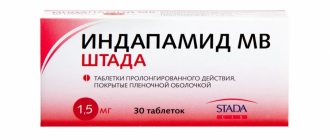Diuretics are one of the groups of drugs used in the treatment of hypertension. Indapamide is often prescribed in the complex treatment of arterial hypertension and some cardiovascular diseases; it allows achieving stable and long-term results, including in the elderly.
Composition and release form
Indapamide is produced by different pharmaceutical companies under several names (for example, Indapamide Stada or Teva) in the form:
- long-acting tablets (their name contains the word retard or the letters MB);
- tablets with a special film coating;
- capsules
In all dosage forms, the active ingredient is the same - indapamide. In long-acting tablets, its dosage can be 1.5 mg, and in regular tablets and capsules - only 2.5 mg. Sold in cardboard boxes of 30 or 60 pieces, complete with instructions.
Auxiliary components are represented by colloidal silicon dioxide, magnesium stearate, lactose, microcrystalline cellulose. But each manufacturer has the right to produce medicine using its own technology, so the composition must be specified in the instructions for the product being purchased.
Effect of the drug
Indapamide has a triple effect:
- has a diuretic effect;
- reduces blood pressure;
- dilates blood vessels.
When taking 1.5-2.5 mg of the drug, a hypotensive effect appears, but without a noticeable diuretic effect. This feature allows the drug to be used to lower blood pressure for a long time.
When the dosage is increased, the hypotensive effect does not increase, but the diuretic effect appears.
A noticeable decrease in blood pressure occurs only after 7 days of taking the medicine; a lasting effect can be expected no earlier than after 3 months.
Thanks to the drug, vascular resistance is reduced by reducing the force of contraction of the smooth muscles of the arteries, and the size of the left ventricle of the heart returns to normal.
Instructions for use INDAPAMIDE PHARMLAND
In patients with hepatic impairment, thiazide-like diuretics may accelerate the development of hepatic encephalopathy. If symptoms of hepatic encephalopathy occur, indapamide should be discontinued immediately.
Water and electrolyte balance
Plasma sodium level:
Before starting treatment with the drug, and then regularly it is necessary to monitor the concentration of sodium in the serum. Any diuretic treatment can lead to low sodium levels with very serious consequences. A decrease in plasma sodium may initially be asymptomatic, so regular monitoring of sodium levels is required. In elderly people or in patients with cirrhosis of the liver, these studies should be performed more often.
Plasma potassium content:
Serum potassium should be monitored regularly during treatment. A decrease in potassium levels with possible subsequent hypokalemia is the main risk of taking thiazide and other diuretics based on it. Prevention of the risk of hypokalemia (<3.4 mmol/L) should be carried out in certain high-risk populations, for example, the elderly, people who are malnourished and/or taking multiple medications at the same time, cirrhotic patients with edema and ascites, patients with coronary vascular disease and hearts. In this situation, hypokalemia increases the cardiac toxicity of digitalis drugs and the risk of arrhythmias. Patients with a prolonged QT interval are also at risk, regardless of whether it is congenital or iatrogenic. Hypokalemia, as well as bradycardia, are a predisposing factor for the occurrence of severe arrhythmias, in particular the potentially fatal atrial flutter-fibrillation. In all of the above situations, more frequent monitoring of plasma potassium levels is necessary. The first measurement of plasma potassium should be performed in the first week of starting treatment. In case of hypokalemia, potassium deficiency should be compensated.
Plasma calcium content:
Thiazide and thiazide-like diuretics may reduce urinary calcium excretion, causing mild transient hypercalcemia. Severe hypercalcemia may result from unrecognized hyperparathyroidism. In this case, it is necessary to interrupt treatment and examine the patient for the function of the parathyroid glands.
Blood sugar level
In patients with diabetes mellitus, especially those with concomitant hypokalemia, it is necessary to monitor blood glucose levels.
Uric acid
Patients with hyperuricemia tend to have an increased frequency of gout attacks. If uric acid levels increase, dose adjustment is necessary.
Kidney function and diuretics
Thiazides and thiazide-like diuretic drugs are fully effective only in the case of normal renal function or only mild impairment (creatinine content below 25 mg/l, i.e. 220 mmol/l). Hypovolemia associated with fluid loss, which may occur at the beginning of diuretic treatment, leads to a decrease in glomerular filtration, which in turn causes an increase in serum urea and creatinine concentrations. Such transient functional renal failure passes without consequences in patients with normal renal function, but at the same time it can aggravate existing renal failure.
Athletes
The drug may cause false-positive anti-doping test results in athletes.
Impact on the ability to drive vehicles and machinery
While taking Indapamide Pharmland, especially at the beginning of treatment or when prescribing another antihypertensive drug for combination treatment, symptoms associated with a drop in blood pressure may occur. In such a situation, the ability to drive vehicles and maintain machinery may be impaired.
Indications for use
The instructions for use contain information about what Indapamide helps with. It is prescribed for arterial hypertension, as well as for chronic heart failure caused by sodium and water retention in the body.
The drug does not affect the metabolism of carbohydrates and fats, therefore it is indicated:
- people diagnosed with diabetes;
- patients with high cholesterol;
- people with one kidney or on hemodialysis.
Indapamide
Undesirable drug combinations
— Lithium preparations:
With the simultaneous use of indapamide and lithium preparations, as well as when following a salt-free diet, an increase in the concentration of lithium in the blood plasma may be observed due to a decrease in its excretion, accompanied by the appearance of signs of overdose. If necessary, diuretics can be used in combination with lithium preparations, and the lithium content in the blood plasma should be monitored and the dose of the drug should be adjusted accordingly.
Combinations of drugs requiring special attention
- Drugs that can cause aritis:
- class I A antiarrhythmic drugs (quinidine, hydroquinidine, disopyramide);
- class III antiarrhythmic drugs (amiodarone, sotalol, dofetilide, ibutilide);
- some neuroleptics: phenothiazines (chlorpromazine, cyamemazine, levomepromazine, thioridazine, trifluoroperazine), benzamides (amisulpride, sulpiride, sultopride, tiapride). butyrophenones (droperidol, haloperidol);
- others: bepridil, cisapride, difemanil, erythromycin (iv), halofantrine, mizolastine, pentamidine, sparfloxacin, moxifloxacin, vincamine (iv), astemizole.
Increased risk of developing ventricular arrhythmias, especially arrhythmias (hypokalemia is a risk factor).
It is necessary to determine the potassium content in the blood plasma and. if necessary, adjust it before starting combination therapy with indapamide and the above drugs. It is necessary to monitor the patient’s clinical condition, monitor the level of electrolytes in the blood plasma, and ECG indicators.
In patients with hypokalemia, drugs that do not cause ari should be used.
— Systemic non-steroidal anti-inflammatory drugs, including selective cyclooxygenase-2 (COX-2) inhibitors, high doses of acetylsalicylic acid (≥ 3 g/day):
The antihypertensive effect of indapamide may be reduced. There is a risk of developing acute renal failure due to a decrease in glomerular filtration rate. Patients need to compensate for fluid loss and carefully monitor renal function at the beginning of therapy.
— Angiotensin-converting enzyme (ACE) inhibitors:
Prescribing ACE inhibitors to patients with low sodium levels in the blood (especially patients with renal artery stenosis) is accompanied by a risk of sudden arterial hypotension and/or acute renal failure.
For patients with arterial hypertension
and, possibly, due to the reduced content of sodium ions in the blood plasma due to the use of diuretics, it is necessary to:
- 3 days before starting therapy with an ACE inhibitor, stop taking the diuretic. In the future, if necessary, the diuretic can be resumed;
- or start ACE inhibitor therapy with low doses, followed by a gradual increase in dose if necessary.
For chronic heart failure
Therapy with ACE inhibitors should be started with low doses, with a possible preliminary reduction in diuretic doses.
In all cases, in the first week of taking ACE inhibitors in patients, it is necessary to monitor renal function (plasma creatinine content).
— Other drugs that can cause hypokalemia: amphotericin B (iv), gluco- and mineralocorticosteroids when used systemically, tetracosactide, laxatives that stimulate intestinal motility:
Increased risk of hypokalemia (additive effect). Constant monitoring of potassium concentration in the blood plasma and, if necessary, its correction is necessary. It is recommended to use laxatives that do not stimulate intestinal motility.
- Baclofen:
There is an increase in the hypotensive effect. Patients need to compensate for fluid loss and carefully monitor renal function at the beginning of treatment.
— Cardiac glycosides:
Hypokalemia enhances the toxic effect of cardiac glycosides. With the simultaneous use of indapamide and cardiac glycosides, the content of potassium in the blood plasma, ECG parameters should be monitored and, if necessary, therapy should be adjusted.
Drug combinations requiring attention
— Potassium-sparing diuretics (amiloride, spironolactone, triamterene):
Combination therapy with indapamide and potassium-sparing diuretics is advisable in some patients, but the possibility of developing hypokalemia or hyperkalemia cannot be excluded (especially in patients with renal failure or in patients with diabetes mellitus).
It is necessary to monitor the potassium content in the blood plasma, ECG indicators and, if necessary, adjust therapy.
— Metformin:
Functional renal failure, which can occur against the background of diuretics, especially loop diuretics, with simultaneous administration of metformin increases the risk of developing lactic acidosis. Metformin should not be used if creatinine levels exceed 15 mg/L (135 µmol/L) in men and 12 mg/L (110 µmol/L) in women.
— Iodine-containing contrast agents:
In case of dehydration while taking diuretics, the risk of developing acute renal failure increases, especially when using high doses of iodine-containing contrast agents. Before using iodinated contrast agents, patients need to compensate for fluid loss.
— Tricyclic antidepressants, antipsychotics (neuroleptics):
Drugs in these classes enhance the antihypertensive effect of indapamide and increase the risk of orthostatic hypotension (additive effect).
— Calcium salts:
With simultaneous administration, hypercalcemia may develop due to a decrease in the excretion of calcium ions by the kidneys.
- Cyclosporine, tacrolimus:
It is possible to increase the creatinine content in the blood plasma without changing the concentration of circulating cyclosporine, even with normal fluid and sodium ion levels.
— Corticosteroid drugs, tetracosactide (for systemic use):
Reduced hypotensive effect (retention of fluid and sodium ions as a result of the action of corticosteroids).
Indapamide: how and in what doses to take
The method and regimen of use depend on the prescribed dosage of the drug.
- A 2.5 mg tablet is taken once a day in the morning. If the hypotensive effect does not appear within 14 days, then the dose is increased to 2-3 tablets per day. The maximum daily dose is 10 mg, which should be divided into two doses;
- a long-acting tablet of 1.5 mg is taken once a day in the morning, but if the effectiveness is weak, after 1.5-2 months the treatment should be supplemented with a drug that is not a diuretic. With long-term therapy, increasing the dose is not advisable due to the increased risk of side effects without normalizing blood pressure.
To eliminate edema in chronic heart failure, Indapamide is prescribed at a dose of 5-7.5 mg per day for 7-14 days.
Is Indapamide safe for pregnant women?
Due to the fact that no serious studies have been conducted on the effect of the drug on pregnant women, tablets and capsules are prohibited during pregnancy. There is a risk of fetoplacental insufficiency, leading to slower fetal development.
The substance can pass into breast milk, therefore, when treating with the drug during lactation, breastfeeding should be stopped.
Indapamide is not suitable for the treatment of physiological edema in pregnancy.
Contraindications and side effects
According to the instructions for use of Indapamide, the drug is contraindicated in:
- hypersensitivity to the main substance;
- acute cerebrovascular accident;
- severe diabetes mellitus;
- advanced form of gout;
- serious renal dysfunction;
- severe liver diseases.
Since the substance removes fluid from the body, it can cause dehydration and a decrease in the concentration of potassium and sodium in the body. In rare cases, arrhythmia and hemolytic anemia may occur.
Main side effects:
- allergies (in the form of skin itching, rash, photosensitivity);
- arrhythmia or tachycardia;
- dry mouth and nausea;
- headache and sleep disturbances;
- epigastric pain;
- constipation or diarrhea.
Taking the drug may provoke changes in well-being due to a decrease in blood pressure, so it is better to avoid activities that require special care.
Indapamide MV (tablets)
Liver dysfunction
When prescribing thiazide and thiazide-like diuretics in patients with impaired liver function, hepatic encephalopathy may develop, especially in the case of electrolyte imbalance. In this case, diuretics should be stopped immediately.
Photosensitivity
While taking thiazide and thiazide-like diuretics, cases of photosensitivity reactions have been reported (see section “Side effects”). If photosensitivity reactions develop while taking the drug, treatment should be discontinued. If it is necessary to continue diuretic therapy, it is recommended to protect the skin from exposure to sunlight or artificial ultraviolet rays.
Water and electrolyte balance
Content of sodium ions in blood plasma
Before starting treatment, it is necessary to determine the content of sodium ions in the blood plasma.
While taking the drug, this indicator should be regularly monitored. Constant monitoring of the content of sodium ions is necessary, since initially a decrease in sodium concentration in the blood plasma may not be accompanied by the appearance of pathological symptoms. The most careful monitoring of sodium levels is necessary for patients with liver cirrhosis and elderly patients (see sections “Side effects” and “Overdose”).
All diuretic drugs can cause hyponatremia, sometimes leading to extremely serious consequences. Hyponatremia and hypovolemia can lead to dehydration and orthostatic hypotension. A concomitant decrease in chloride ions can lead to secondary compensatory metabolic alkalosis: the frequency and severity of this effect are insignificant.
Content of potassium ions in blood plasma
When treating with thiazide and thiazide-like diuretics, the main risk is a decrease in the concentration of potassium in the blood plasma and the development of hypokalemia. It is necessary to prevent the risk of developing hypokalemia (potassium content less than 3.4 mmol/l) in patients at high risk in the following categories: elderly, debilitated and/or receiving concomitant drug therapy, patients with liver cirrhosis, peripheral edema and ascites, coronary heart disease, heart failure. Hypokalemia in patients of these groups increases the toxic effect of cardiac glycosides and increases the risk of developing arrhythmias.
In addition, patients with an increased QT interval, both congenital and drug-induced, are at increased risk.
Hypokalemia, as well as bradycardia, is a condition that contributes to the development of severe arrhythmias and, especially, polymorphic ventricular tachycardia of the “pirouette” type, which can be fatal. In all the cases described above, it is necessary to regularly monitor the concentration of potassium in the blood plasma. The first measurement of the concentration of potassium ions in the blood must be carried out within the first week from the start of treatment. If hypokalemia occurs, appropriate treatment should be prescribed.
Calcium content in blood plasma
It should be borne in mind that thiazide and thiazide-like diuretics can reduce the excretion of calcium ions by the kidneys, leading to a slight and temporary increase in the concentration of calcium in the blood plasma. Severe hypercalcemia may be a consequence of previously undiagnosed hyperparathyroidism.
Diuretics should be discontinued before testing parathyroid function.
Plasma glucose levels
It is necessary to monitor blood glucose concentrations in patients with diabetes mellitus, especially in the presence of hypokalemia.
Uric acid
In patients with gout, the frequency of attacks may increase or the course of gout may worsen.
Diuretics and kidney function
Thiazide and thiazide-like diuretics are fully effective only in patients with normal or slightly impaired renal function (plasma creatinine concentration in adult patients below 25 mg/l or 220 µmol/l). In elderly patients, the concentration of creatinine in blood plasma is calculated taking into account age, body weight and gender.
It should be taken into account that at the beginning of treatment, patients may experience a decrease in glomerular filtration rate due to hypovolemia, which, in turn, is caused by the loss of fluid and sodium ions while taking diuretic drugs. As a result, the concentration of urea and creatinine in the blood plasma may increase.
If renal function is not impaired, such temporary functional renal failure, as a rule, passes without consequences, however, with existing renal failure, the patient's condition may worsen.
Athletes
Indapamide may give a positive result during doping control in athletes.


